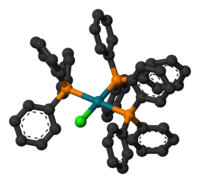
Photo from wikipedia
Nickel-catalyzed catalyst transfer polycondensation (CTP) of thiophenes is an efficient strategy for the controlled synthesis of polythiophenes. However, a detailed view of its reaction mechanism has remained elusive with unresolved questions… Click to show full abstract
Nickel-catalyzed catalyst transfer polycondensation (CTP) of thiophenes is an efficient strategy for the controlled synthesis of polythiophenes. However, a detailed view of its reaction mechanism has remained elusive with unresolved questions regarding the geometry and bonding of critical Ni(0) thiophene intermediates. Herein, we provide experimental and computational evidence of structurally characterized square planar η2-Ni(0)–thiophene species and their relevance to the mechanism of CTP. These results confirm the viability of C,C-η2 bound intermediates in CTP of thiophenes, providing an electronic rationale for the stability of such species, and thus that such processes can proceed as living polymerizations. We further show that C,S-κ2 species may also be relevant in nickel-catalyzed CTP of thiophenes, providing new avenues for exploitation and optimization.The mechanism for nickel-catalyzed catalyst transfer polycondensation of thiophenes to polythiophenes. Here the authors show experimental and computational evidence of structurally characterized square planar η2-Ni(0)–thiophene species and their relevance to the mechanism of catalyst transfer polycondensation.
Journal Title: Nature Communications
Year Published: 2018
Link to full text (if available)
Share on Social Media: Sign Up to like & get
recommendations!